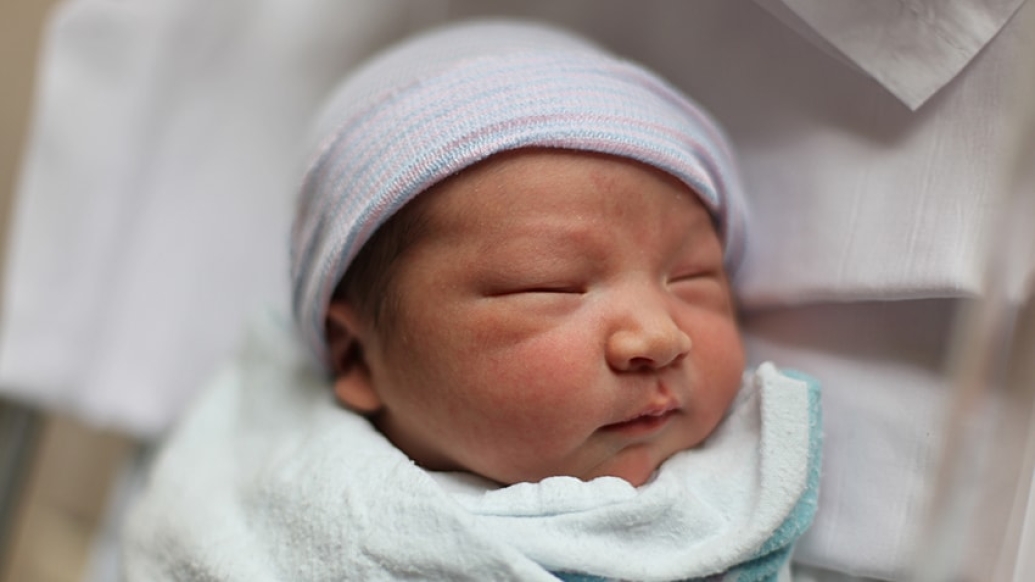Knowing the facts about what does (and doesn’t) cause larger newborns can provide comfort for parents-to-be.
7:00 AM
Author |

Giving birth is never easy. And hearing from a doctor that your little nugget isn't so little may cause expectant mothers added anxiety.
MORE FROM MICHIGAN: Sign up for our weekly newsletter
Big babies can pose a challenge — but not as much as parents might fear.
"There are a lot of myths out there," says David Marzano, M.D., an OB-GYN at University of Michigan Von Voigtlander Women's Hospital.
The medical term for a large baby is macrosomia. A newborn receives this designation if he or she weighs 8 pounds, 13 ounces or larger at birth.
About 8 percent of the nation's deliveries involve babies with macrosomia, according to the American College of Obstetricians and Gynecologists. But only 1 percent of newborns weigh 9 pounds, 9 ounces or more.
Marzano debunked some of the myths he hears from moms-to-be:
Myth: Baby size predictions are always right
Marzano uses three methods to predict a baby's size but he readily admits they're far from foolproof. The first is Leopold's Maneuvers, which involves a doctor using both hands on the mother's belly to feel the baby's parts to determine size and location in the uterus.
"After a few years of experience, you get pretty good at predicting how big a baby is going to be with this method, but sometimes you're surprised," says Marzano, who delivered the largest baby of his career on the first day of his internship: a 12-pound, 6-ounce bundle of joy.
He also does his own research, asking the patient her birth history and using observational skills to see if both parents are unusually tall or heavy, often good predictors of a bigger baby.
The final tool is an ultrasound during the third trimester. But predictions using this technology can be off by as much as 20 percent, meaning a baby expected to weigh 10 pounds could be anywhere from 8 to 12 pounds. It is the least accurate tool late in this pregnancy stage, Marzano says.
Myth: Pregnant women who gain weight have bigger babies
Marzano has seen his share of patients who say they are bigger than their previous pregnancy or gained next to nothing compared to their last child.
SEE ALSO: Pregnant and Want Advice on Healthy Weight Gain? Google Isn't Your Best Bet
This is not as important: "I've had these tiny women who've gained practically no weight and who exercise regularly give birth to large babies," he says. "It makes me think, hmm, nature's weird."
Mothers with uncontrolled diabetes, both pre-existing and gestational — which first develops during pregnancy — run a higher risk of having babies with macrosomia.
Other influential factors include mothers with obesity, those with a prior history of macrosomia and babies who are overdue.
Moms with diabetes, whether gestational or a pre-existing sugar issue, must control their sugar with diet and exercise to avoid high sugar levels, Marzano explains.
The reason? Women with high sugar pass that glucose through the placenta. The baby's pancreas senses it and makes more insulin to handle that higher load of sugar, a process that converts it into fat. The end result may be a larger baby.
Meanwhile, the higher sugar poses risks to the child after being born.
"That baby has to be monitored closely for several hours because it's used to releasing more insulin because of mom's sugar," Marzano says. "When you clamp the cord, you take away the baby's sugar supply and the baby's blood sugar drops because there is more insulin present."
Myth: A pregnant mother should eat for two
Should a mom-to-be double up at mealtime?
"That's a myth," Marzano says. "It probably came from a good place long ago when malnutrition was an issue, but that's not a huge problem in the United States."
Marzano says that it wasn't long ago when doctors advised every expectant woman to gain 30 to 40 pounds. Now, guidelines depend on mom's starting weight. Average-weight mothers should gain 20 to 30 pounds; women who are overweight should shoot for 10 pounds. Women with obesity should stay the same weight, while morbidly obese women may lose weight, even while pregnant.
"Minimizing the weight gain is a better target than telling someone to lose weight, but letting them know that may prevent a 50-pound weight gain," Marzano says.
Myth: Vegetarian diets prevent macrosomia
Giving up steak and seafood won't affect a newborn's weight.
"There is no evidence that a vegetarian has a lower risk of having a big baby than a person on a regular diet," Marzano says.
While a healthy lifestyle can positively impact a growing baby, genetics can also play a large role, especially when it comes to conditions like gestational diabetes.
"Hormones that are involved with gestational diabetes are often not something mom can influence, and the higher blood sugar levels caused by those hormones can result in larger fetal growth," Marzano says, adding that the condition can occur even in women who have no risk factors.
Myth: Large babies must be delivered via C-section
The risk of complications to both mom and baby increases with a newborn's size, but that doesn't mean a cesarean delivery is necessary, Marzano says. Both patient and doctor will discuss the risks and consult fellow medical experts.
If multiple signs indicate a baby will weigh more than 9 pounds, 9 ounces, the American College of Obstetricians and Gynecologists suggests a C-section.
If a patient chooses a traditional delivery, the patient is advised that she may receive an episiotomy (a surgical cut made at the opening of the vagina) or experience vaginal tears because special equipment like forceps may be used.
One of the most common problems during a vaginal delivery is shoulder dystocia, which occurs when a baby's shoulder gets stuck under a mother's pubic bone. It is considered a medical emergency because the baby is stuck in the birth canal and the umbilical cord is depressed, cutting off the oxygen supply.
To get the baby out, a doctor will have to perform several maneuvers to relieve the shoulder dystocia. This can include breaking the baby's clavicle, if it hasn't happened naturally in the birthing process. Permanent nerve injury or paralysis might occur, making the arm weak or unusable.
If that doesn't help move the baby, fetal death may occur.
That said, scaring expectant moms is the last thing Marzano wants to do. Awareness, he knows, is the key to making an informed decision free of mistruths or myths.

Explore a variety of health care news & stories by visiting the Health Lab home page for more articles.

Department of Communication at Michigan Medicine
Want top health & research news weekly? Sign up for Health Lab’s newsletters today!





